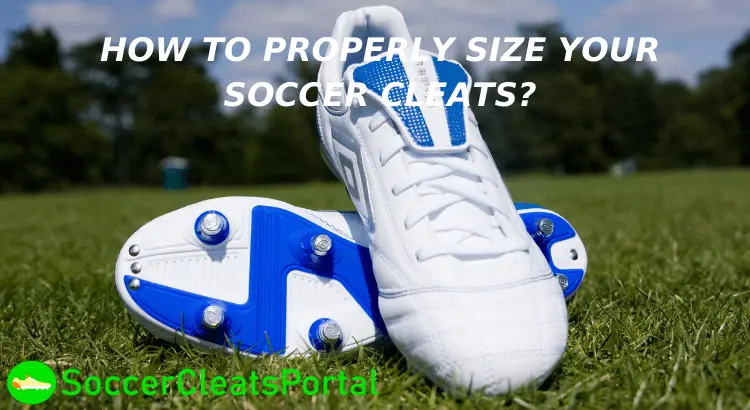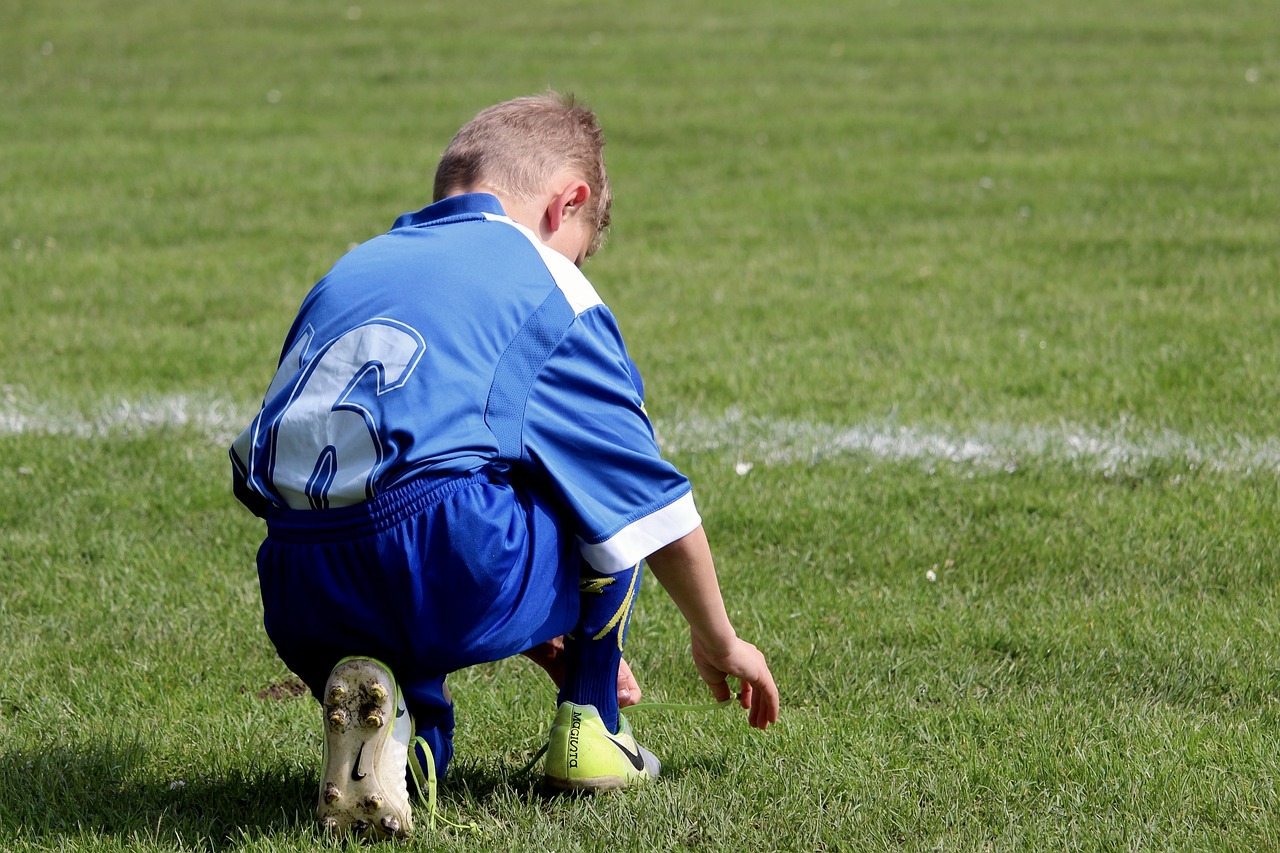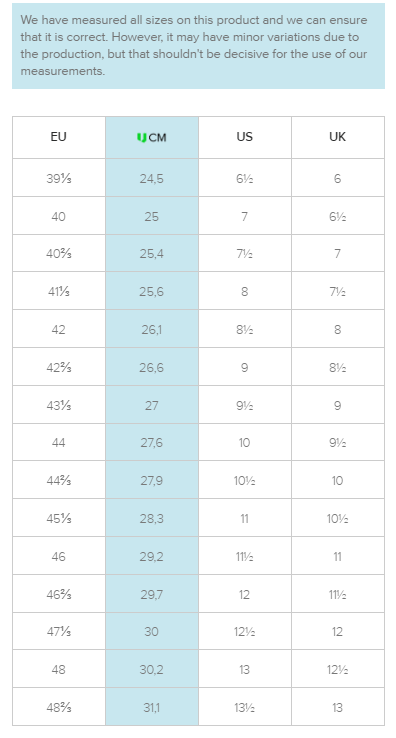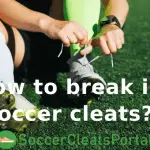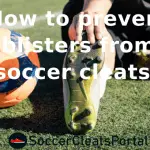How to properly size and fit your soccer cleats is probably the biggest thing that a lot of people get wrong when they are buying a brand-new pair. It’s one of the worst things that can happen when you get a new pair of boots, but sadly it’s one of the most common mistakes you can make in terms of getting the most out of your new pair of football boots.
But how to get the right size for my soccer cleats? In order to properly sized your soccer shoes, there are three main things you must consider. The first thing is the age and the fact that your foot may or may not grow, secondly is the type of shoe you’re looking at and more specifically the materials used and then lastly how wide or narrow your foot is.
What to consider when choosing the size of your soccer cleats?
Shoes can play a very vital role in terms of performance if you’re not wearing the right shoes you are probably not playing as well as you could. And if you are looking to spend around $300 especially for high-end models you do not want to be buying a shoe that does not fit you well. So you need to consider the following.
- Your Age
Firstly, when you are sizing children who still are growing you may need to consider that if you are buying cleats at the start of the school year you’re not going to buy them so they fit perfectly but you’re going to buy them with extra growing room so you don’t grow out of them through the lifespan of the shoe. You want to have them fit you for as long as the shoes last. So the rule that we use for this is leaving probably less than half a thumb maybe a third of a thumb space left between the toes and the end of the shoe.
You need also to consider how often you are going to use them. If you are a kid and you only have one pair of shoes that you wear every day for an entire season it is likely that they’re going to wear out pretty quickly and they’re likely going to need replacing before your foot outgrow them. In that case, you’d better buy a shoe that fits perfectly without any spare room inside.
- Shoe materials
Materials will play a very large role in how soccer cleats will actually fit. There are several different materials used in the construction of soccer cleats. First off you’ll have your standard synthetic, then you have the knit uppers something that advertised by Nike as Flyknit and then lastly there is the good old classic leather shoe.
When you’re looking at a shoe that is using synthetic materials that will not stretch much over time. So the shoe that you try on the first time that’s the way it’s going to feel down the line. Synthetic is made to last in that same shape since it’s not a natural material. So if you feel that the shoe is uncomfortable in the store that the cleat does not fit well at all.
However, if you’re looking at a leather shoe this can be different. Within the leather shoe category, there’s a couple of different leather types such as kangaroo leather, calfskin leather and others. Leather material is very easily stretchable so if in the store the shoe fits a little bit tighter that’s okay especially since the shoe will stretch out over time and form to your foot.
Lastly, another big category of uppers is the knit uppers (Nike uses the term Flyknit and Adidas the term Primeknit). This is a machine-woven material that is supposed to mimic the stretchability of leather but still gives you that tight feeling of a synthetic shoe. It does stretch quite a bit over time so when you’re buying knitted shoes I would look at it similarly to leather. They won’t stretch a ton and like some leather shoes but they are going to stretch so you need to consider that before purchasing.
Finally, you need to consider if the shoe has laces or not. With the laces, you can tighten them and adjust the fit of the shoe at some point. But if you don’t have the laces the length and the width has to fit you perfectly.
- Foot shape
Lastly, you want to figure out what sort of shape your foot has. When you’re talking about how a soccer cleat actually wraps your foot there are two main aspects. The sizing which has to do with the length of the shoe and the fit which has to do with the general structure of the shoe, it’s the width and the way it wraps up your foot.
So the first thing to do is to measure the length of your foot. Note here that some people may have different-sized feet.
Then you want to figure out if your foot is a little bit wider or if it’s a little bit narrow or if it’s just right in between because this will determine what kind of boots you can actually wear. Some boots are more catered towards wider feet and some cater towards narrower feet. You should not try to squeeze your foot in. Also, if you have flat feet, you should choose your shoes wisely.
I’ve seen a lot of people that have a wide foot, they actually just go up a size because they think that if it’s a size longer it’s also going to fit wider accordingly. However, then you’ll have a shoe that’s way too long just in order to compensate for a wide foot. Make sure that you’re getting a shoe that fits both lengthwise and widthwise.
How to measure the shape of your foot?
In order to measure the shape of your you can follow the steps below:
- Firstly you need to wear a pair of socks.
- Then you need a piece of paper and a pen. Put your foot on the piece of paper and draw around it.
- Mark the bottom point and the very top point on your foot and join them together with a straight line. Similarly for the width, mark the two widest points of your foot and draw a line to join them.
- Finally, measure the lines and with that, you have calculated to length and the width of your foot.
Alternatively, you can use the foot size charts for men, women, and kids, made from soccer.com.
Then go to the unisportstore.com website and check out a size guide. There you can use a specific size guide for each individual boot and not a general size guide for Nike for example. They have actually measured the length of some of the most popular shoes like the Adidas Copa Sense below and that can be very handy when choosing the appropriate size for your shoe.
Soccer.com has made a useful chart for every brand here. Of course, you can visit the site of every brand for more info.
The second thing here is the width. Nailing down the width is not the easiest thing in the world. When it comes to width there is not any measurement system in place. Some cleats are narrower than others depending on their construction. So when it comes to the width you can only be sure only by trying them.
Of course, you can estimate how wide is your foot. After you have measured your width as shown above you can visit this site and check how wide is your feet compared to their length.
Now if you have wide feet you would better go for a leather boot. If you are wanting to try some of the synthetic boots, New Balance is one of the few brands that actually offer a wide-fit boot in their synthetic options. Also as a general rule, Adidas and New Balance shoes tend to be wider than the other brands while Puma cleats tend to be tighter.
After you have measured your foot shape you can start trying shoes close to your foot length. Remember to always bring in a pair of socks when you go to try shoes and make sure you got them all the way laced up.
Do soccer cleats run big or small?
One of the bigger issues that people have when trying to find the best shoe is that there is not any universal size and every brand has its own measurement system. Each brand has a different size and some run smaller or bigger than the other brands. For example, when you buy a pair of Nike boots in size 41 it has a different fit than an Adidas 41 size shoe.
Every brand has 4 different sizing types. There’s the US sizing, the UK sizing, the European sizing, and the Japanese sizing.
A size 9 US in Nike is the equivalent of an 8 UK. On Adidas shoes, a size 9 US is the equivalent of an 8.5 UK. So you can see that there’s a difference there between these two major brands. As you can imagine if in Nike you are wearing an 8 UK size that doesn’t mean that an 8 UK size on Adidas will fit you well. The same difference happens if you compare the European size between these two brands. Identical are the differences if you compare the sizes of Puma with Nike and Adidas. On the other hand, the Japanese type seems to be more accurate when comparing brands.
The key advice here is to try on different boots from different brands and to figure out which is your Nike size, which is your Puma size, which is your Adidas size etc.
How much space should you leave at the end of your soccer cleats?
The answer to that question is that it really just depends. When it comes to how much space you leave at the end it’s very much based on personal preference. Everyone likes the fit and feel of the soccer shoes a little bit different. So what needs to be prioritized here is that they feel comfortable on your feet. If there happens to be roughly about a half thumbs width of space at the end, that’s perfectly fine as long as you’re comfortable with it.
Many say that leaving a thumb or a half of a thumb width of space at the end will work fine but this is a little bit too generic for my liking. Everybody’s got a different shaped thumb and every single person has different shaped feet and toes. There are too many variables that aren’t consistent to give a straight-up answer to that question.
But as a general rule, there shouldn’t be an excessive amount of space at the end of the toe box and it should be as little as possible without feeling uncomfortable. When trying on brand new boots you shouldn’t be able to feel any extra space on the inside of the boots either at the end of your toe or on the sides of the boots.
The sizing is the most important factor when it comes to fitting a soccer shoe properly because if the sizing is wrong everything else will be wrong. Soccer cleats are made to wrap your foot very tightly. If the sizing is wrong your foot will not sit in the correct parts of your shoe. You are spending extra money on a high-end shoe for all the innovative technology that is used in their construction and their exceptional fit. If you deliberately buy unfitting shoes, that defeats the purpose of buying that expensive product in the first place.
For those that are buying the shoes for their kids and want to leave extra space for the sake of growing room, my general advice is that if you’re buying boots that you need to wear right now they should fit you properly right now. Soccer cleats nowadays are not as durable and if you are playing with them a lot you will most probably need to replace them before needing to go one size up. The likelihood of you outgrowing your boots before they actually need to be replaced it’s very unlikely.
Finally, keep in mind that soccer cleats are inevitably going to stretch regardless of what the upper material is either by wearing them or while in the break-in process. Obviously, if they’re leather they’re gonna stretch a little bit more than synthetic boots. But as the boots stretch in width that’s going to allow for even more space towards the front of the boot. So if there’s already a little bit too much space and you start wearing them and they stretch a little bit there’s probably going to be too much space and you ended up with boots that are now too big for you.
Disadvantages of wearing excessive or short soccer cleats
If you’re wearing boots that are too big for you and they’re flopping around that is going to affect your ability to play. By wearing excessive cleats you will lose the feeling of the shoe. That can result in your cleats colliding with the ground when trying to kick the ball.
Also, you may feel slippage whether it’s in the heel, or in the forefoot, or in the toe box area and that can lead to the appearance of blisters.
On the other hand, if the shoes are too short your toes are just going to jam in and that will feel horrible.
Furthermore, soccer cleats that do not fit perfectly tend to downgrade a lot faster.
In general, if the shoe is too big or short you will lose the performance benefits and the overall stability is not going to be good.
How tight and snug should soccer cleats be?
A lot of people tend to compare the fit of their soccer shoes to the other type of shoes that they are wearing casually. But they’re not designed for the same use and they’re not supposed to fit the same way. Soccer boots are designed to fit more snug than regular sneakers because when you’re dribbling or striking the ball, you want them to fit as close to your foot as possible to allow for a better touch, better feel, less sloppiness and in turn better performance. So compared to regular shoes, when it comes to soccer cleats you will need a smaller size. How much? That will vary between the different soccer boot brands.
You are playing a sport in them so you want them to perform to a certain standard in regards to stability, traction, general comfort as well as just having a good touch on the ball. So soccer cleats are made to wrap your foot very closely with no extra space on the inside. They are supposed to act somewhat like a second skin to your foot.
A lot of people just consider the very end they don’t consider the sides. There’s should not be any dead space going around the edges and the midfoot. Basically, you want your soccer shoe to fit pretty snug on both sides of your feet you should never be able to slide your foot from side to side on the inside of the shoe. This makes for a more responsive feel and stability.
The fit in the heel should also be very good and not having any slippage issues. The heel should provide a lockdown feel without leaving the ability for the foot to slide forward.
Use your own discretion when it comes to how the shoe fits your foot but just keep these things in mind next time that you’re trying on a brand new pair of shoes. Make sure the shoe fits your foot completely good not just the very end.
Soccer boots should feel comfortable out of the box and if there’s any kind of sloppiness they’re probably not the right boots for you or you just have the wrong size.
What do you do if your soccer cleats are too small?
Buying boots online is pretty much a normal thing these days given that a lot of people don’t have access to a local store and the fact that you can get just better prices. But getting the proper fit can sometimes be a little bit tricky because if you’re ordering online you’re not able to try them on until the boots arrive at your house.
If you order from an online retailer you must be aware of what their return policy is. Often these exchange policies are 100% free of charge meaning that you can send them back and they’ll send you the right size at no cost. Of course, you should not wear and play with them as you will not then be able to return them.
If you put a pair of boots on and they’re just way too small and can be sure that they’re never going to stretch enough and it’s probably best to return them and get the right size. But if they just feel a little bit too tight but not uncomfortable and you can tell after a little bit of stretch that they can become pretty much perfect you can maybe give them a chance and let them stretch out especially if they are leather boots. If it’s a bit tight you can also replace the insole with a thinner one.
On the other hand, the soleplate is made of hard plastic and it cannot stretch as the upper. So if you can feel that the boots are too small from the base, it’s best to return them and get a bigger size.
What do you do if your soccer cleats are too big?
If you have bought cleats that do not fit well and you do not have the option of returning them, there are some tricks that you can use to fix that issue at a certain level.
Ankle braces are a great tool used by many athletes to support their ankles.
In our case, you can use them to minimize the space between your toe and the shoe end.
- Use thick socks or an extra pair of grip shocks.
This is another useful measure you can take to minimize your gap in the front of your lengthy shoe and eat up the spare space in the boot.
- User thicker insoles.
If the inside of your shoe feels loose while moving, you can get yourself a thicker insole.
- Wrap up the shoe with a boot tape.
That can give a tighter fit as it compresses and keep the boot on.
- Wrap up the shoe with longer laces.
You can wrap them around the bottom and that would give you that extra compression.
These tricks are only inadequate measures to help you resolve at some point that problem. If you are a recreational player you can use them for some playing sessions but if you are serious about your game your priority would be to find the perfect boot for your needs.
Final thoughts – My advice
The best-case scenario is that you live near a soccer store you can go ahead and try on all kinds of different shoes and pick a pair from there. But most people these days order their boots online and it can be tricky to figure out which boots are going to be comfortable which ones are going to fit you properly in general.
The most common mistake that a lot of people do is to change the size of the shoe in order to get a proper fit in the width. If The length is perfect but the width doesn’t match your foot type you shouldn’t go for a size up as then you will have a wrong fit in the length. If a shoe doesn’t fit you in your true size it isn’t the shoe for you. On the opposite, if your foot is really narrow and you do not fill out the shoe but you really want that shoe don’t get it. Because even if you downsize to make it fit widthwise the length is going to be too short.
The perfect boots should fit great just out of the box and you should never go up or down half the size or even a full size to accommodate for a wide foot or narrow foot respectively.
When it comes to sizing your soccer cleats you should be honest with yourself and if you have a particular pair of shoes you really really like and then you’ll try it on and it just doesn’t feel the way you were hoping, then don’t buy it.
Soccer boots these days are anatomically constructed to follow the shape of your foot closely in order to get the best performance. If you are very serious about this game and you’re serious about playing well then you should take advantage of the technology implemented on the construction of soccer cleats and get your boots to fit as snugly as possible.
I’m not saying that shoes will make you a better or a worse player but if you’re wearing shoes that don’t fit you properly that will impact the way that you play and your overall enjoyment of the game. You have probably paid extra money for that superior fit and the performance qualities of that shoe so you want to get everything that the shoe is intended to provide.
The final aspect of getting the right size and fit from your new pair of shoes is that you have to think for yourself and use your own discretion and find the perfect balance between a tight fit and how comfortable the shoe feels in your foot. Yes, you can ask for help up to a certain point but once that shoe is on your foot you have to be able to decide for yourself whether or not you like how it feels or not. So finding the proper fit is a lot of trial and error.
